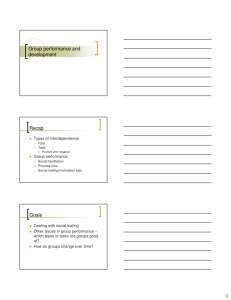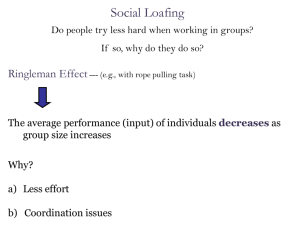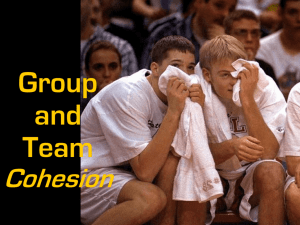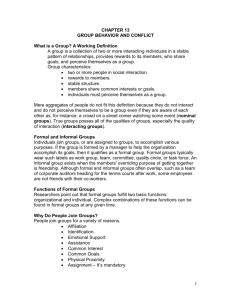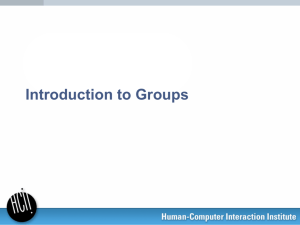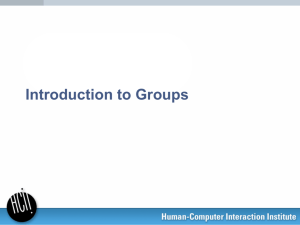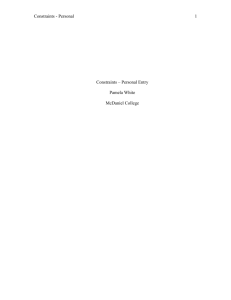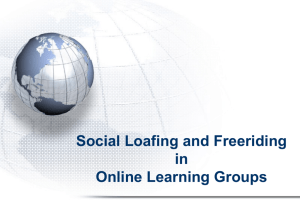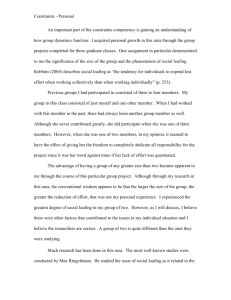Introduction to Groups
advertisement
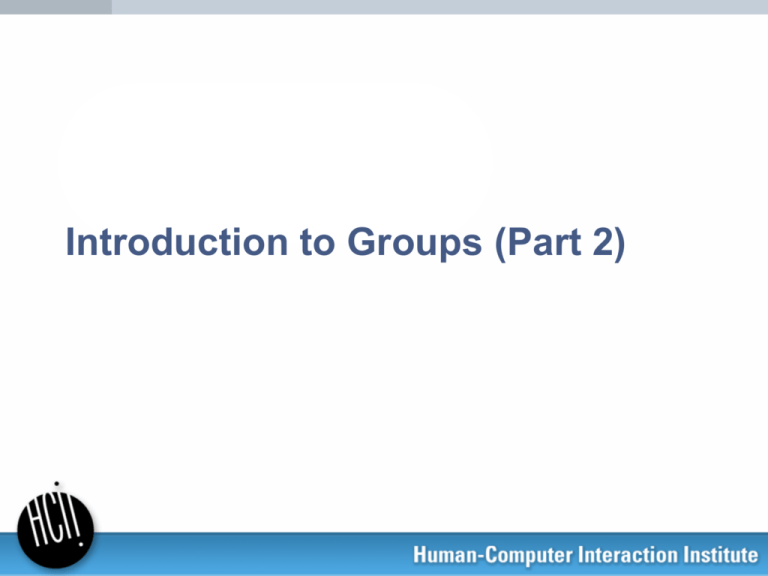
Introduction to Groups (Part 2) The tension in group work • • Groups are valuable: Perform better than the individuals who comprise them But they rarely live up to their potential = Process losses. Knowledge Skills Attitudes Time Effort Potential Potential Performance Performance What group problems have you had? • Situations where you thought a group you were part of didn’t live up to expectations? Problems in Groups I’ve Supervised in Industry & Academia • Every year 1 or 2 groups struggle with problems of group dynamics – – – – – – – – – Uneven amount & quality of contributions (social loafing) Conflict over goals Conflict over assignments Conflict over standards Task conflict spill over into personal conflict Difficulty dealing with differences between members Difficulties in coordination Disappointment with what they have learned Groups don’t deliver what the client wanted Social Loafing “George was a problem in our group, never contributed to any of our group meetings at all, he would just get his laptop out as soon as he sat down and then just surfed the web on it. We continually asked him to participate in the work, close his laptop, etc. but all he did was read website forums on [his hobby] and edit Wikipedia pages about it. At best he didn't contribute to the group and ignored us. At worst he would join the conversation underway and say something that required us to to break what we were talking about to go back and discuss with him about something that the group had already decided about 30 minutes ago on. We purposefully did not let him present to the class because we, as a group, have no idea what he even really knows about our project and we didn't think that he would be able to speak about it well. He contributed nothing to the project. Not Being Listened To “As you are (or should) be aware, I have had difficulties dealing with the group dynamics existing in our project group. I’ve tried several strategies to be able to cope with them: exposing the problem to you, ignoring these difficulties and trying to make my point anyway,. … I’ve also tried to make my voice be heard and to speak up more as you told me to do, but even this has not worked. … I’m disappointed with myself for not being more assertive and authoritative and for not knowing how to deal with this situation better; I am disappointed with you for not being willing to listen and incorporate my ideas into the group and for not considering me as a real member of the group. As a result, I feel that our work so far is not representative of our qualities and skills. We have been able to produce very little as a group and this is even more upsetting that the personal feelings I have endured with this group.” Personality Clashes A European member from a culture with a very direct way of speaking had a major role and others were upset and/or intimidated by his direct manner. A lot of fighting broke out. In this case, a consultant worked with the team and they learned how to work well enough together to pull together a nice project and the client was pleased. Types of Process Losses Coordination • Coordination costs of – Scheduling – Developing consensus – Doing the work • • • Production blocking: members can not think of new ideas while listening to someone else Common knowledge effect: discussions focus on shared information Unequal participation: participation expertise Motivational • • • • • Social loafing: members expend less effort when working with others Conformity pressures: members feel pressured to agree with the group rather than share dissenting information Conflict: interpersonal conflict is disruptive In-group vs. Out-group bias: Mere group membership leads to in-group favoritism. Escalation of commitment: groups persist in following a course of action despite evidence against it Alex Osborne’s Rules for Brainstorming (1953) • • • • Work in groups No criticism Defer criticism. Encourage the wild – Wild ideas may trigger more practical suggestions from others – It is easier to tone done crazy ideas than to be creative • The more the better – The more ideas, the greater likelihood of one winner – It is easier to eliminate than to generate • Build off of others – Combinations and improvements are welcome – How can you improve what others offered? – Can you get creativity from combinations? Osborne, A. F. (1953). Applied imagination: Principles and procedures of creative problem solving. Charles Scribener’s Sons, New York. Wikipedia article on brainstorming Process Loss in Brainstorming 120 In real, interacting groups (versus nominal ones) Fewer ideas Fewer good ideas Lower average quality Lower feasibility How you attempt to rectify this depends on why this occurs What can cause the problem? 100 Number of ideas 80 60 40 20 0 Real group Nominal group Number of ”good” ideas produced by interacting and nominal 4-person groups discussing how to improve relationships among Germans & guest workers (Diehl & Stoebe, 1987) Possible explanations • • • Explanation Conformity pressures Production blocking Social loafing • • • Solution Anonymity Simultaneous input Surveillance systems Production Blocking is the main problem Brainstorm at home & use group meeting to consolidate Other techniques to enhance brainstorming • Take a break • Brainstorm within categories • Division of labor Social Loafing RINGLEMANN’s Discovery (1913) • • • • A French agricultural engineer who conducted most of his research in late 1880’s. Device measured the exact mount of forced exerted on the rope 1, 2, 3, or 8 people pulling on rope Force didn’t increase linearly with the number of people Social Loafing: RINGLEMANN (1913) • Mean force pulled by individuals = 85.3 kg of force • Eight people should produce (8*85.3kg) or 682.4 kg of force, but really produce less than half ` Why? Nominal or co-acting groups. Subjects think they are in the presence of a group, but in fact acting alone motivation Real (or collective) groups need to shout at the same time coordination Sound pressure (Dunes per cm2) Distinguishing Coordination Problems from Motivation 10 Nominal group (coactive) 9 8 7 6 5 4 Real group (collective) 3 1 2 Group size 6 Social Loafing: Working in a group decreases effort • • Social loafing occurs in both interacting and nominal groups Across many performance outcomes – – – – Physical Intellectual Quantity Quality When is social loafing reduced? Brainstorm uses of a knife. Place ideas into – Separate boxes (coactive) – Common box (collective) Group cohesion – High Cohesion: Prior pleasant interaction – Control: No conversation – Low Cohesion: Prior argumentative interaction. Numberof ofunique uniqueideas ideas Number Loafing reduced in cohesive groups 40 Coactive group Coactive group 35 30 25 20 15 10 Collective group Low Social loafing occurs – In no history control group – In low cohesion group – Eliminated in high cohesion group Control High Cohesion Karau, S. J., & Hart, J. W. (1998). Group Cohesiveness and Social Loafing: Effects of a Social Interaction Manipulation on Individual Motivation Within Groups. Group Dynamics: Theory, Research, and Practice, 2(3), 185-191. People even work harder in a cohesive group when they think teammate has low ability • Subject performs a brainstorming task • Vary individual vs. collective work • Individual: Put ideas in separate boxes Collective: Put ideas in common box • Vary group cohesion • Friends vs strangers • Vary perceived ability of others in groups • • Low: “I’m lousy at this type of task” High: Irrelevant comments or “I’m generally good at this type of task” High cohesion 40 Number of Ideas • Low cohesion 30 20 10 0 Individual Collective Low ability coworker Individual High ability coworker • Social loafing results: • • Collective With low-ability partners, social loafing occurs in non-cohesive groups, but reduced in cohesive groups With high-ability partners, social compensation occurs in cohesive groups, but not in noncohesive groups Karau, S. J., & Williams, K. D. (1997). The effects of group cohesiveness on social loafing and social compensation. Group Dynamics, 1(2), 156-168. Karau & Williams Meta-Analysis Meta-Analysis – Way to systematically combine evidence from many studies by averaging effect sizes – Effect size = power of variable of interest in standard deviations units Karau & Williams result – 163 effect sizes – 123 of 163 studies show evidence of social loafing • People working harder in coactive conditions than collective conditions – Mean effect size = .44 standard deviations (moderate) Illustrating Average Effect Size • Difference of .44 standard deviation units btw effort when individuals are working independently (coacting) versus pooling output (collective) – Small to moderate effect size – 66% of people in collective group would exert less effort than averager person in the co-acting group – Comparable to difference in height between 14 year old & 17 year old girl or the difference in reading or math tests of 5th graders vs 4th graders or reading differences between 12th grade girls vs boys .44d Collective Co-acting What causes social loafing? Expectancy-Value Theory (Vroom) Individuals will work hard in groups to the extent they believe: – effort will lead to better performance – better performance will be recognized and rewarded – the rewards are valuable Utility model of individual motivation Quasi-economic model Individuals work hard to the extent that doing so increases personal payoffs individual performance individual outcome individual effort x Valance of outcome individual utility motivation You study hard (effort) – – – – If you enjoy the topic (intrinsic motivation) You have a test (individual performance) You ace the test (individual outcome) You are proud & get praise from parents (evaluation of outcome) Collective Effort Model (Karau & Williams) • Being in a group – Changes probability of outcome – Changes valence of the outcome individual performance individual effort individual outcome x group performance Number of others Own competence Own unique skills Group’s incompetence Valance of outcome individual utility motivation group outcome Liking for group members Identification with group History of interaction with group Personal importance of goal Identifiably Divisibility of outcome Fairness of reward distribution Factors that mitigate social loafing Social loafing reduced if • Individual's output is visible • Task is attractive • Group is attractive • Expect others to perform poorly • Own contribution is unique • Task is simple • Task has specific, challenging goals • Among women • Among people from collectivist cultures Karau, S. J., & Williams, K. D. (1993). Social loafing: A meta-analytic review and theoretical integration. Journal of Personality & Social Psychology, 65(4), 681-706. Scenario • • You are member of a 4-person team to select a Wikipedia article & improve it to good article status How do you guard against social loafing? Ways to reduce social loafing • • • • • • Assign fewer people to work on tasks (“understaffing”) Assign individual responsibilities Make individual performance visible Define clear, stretch goals Make the tasks intrinsically interesting Make the group enjoyable to work in Approaches may differ across cultures Social loafing experiment - # of “in box tasks” in an hour US or PRC management trainees Personal accountability: Individuals signed their work or were anonymous Shared responsibility: Told they were in a nominal group of 10 and given a group goal of 200 items • • • • PRC US Anon Identified Anon 26 26 24 24 22 22 20 20 18 18 Identified 16 16 14 14 No Team Goal Team Goal No Team Goal Team Goal Earley, P. C. (1989). Social loafing and collectivism: A comparison of the United States and the People's Republic of China. Administrative Science Quarterly, 565-581.
